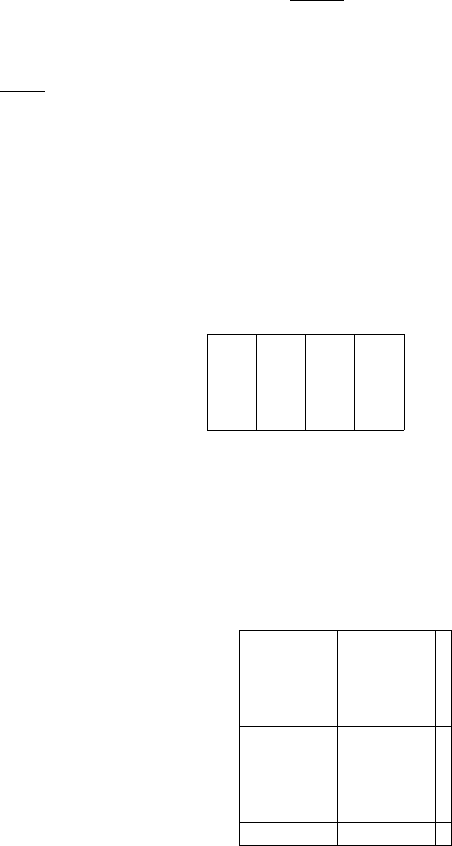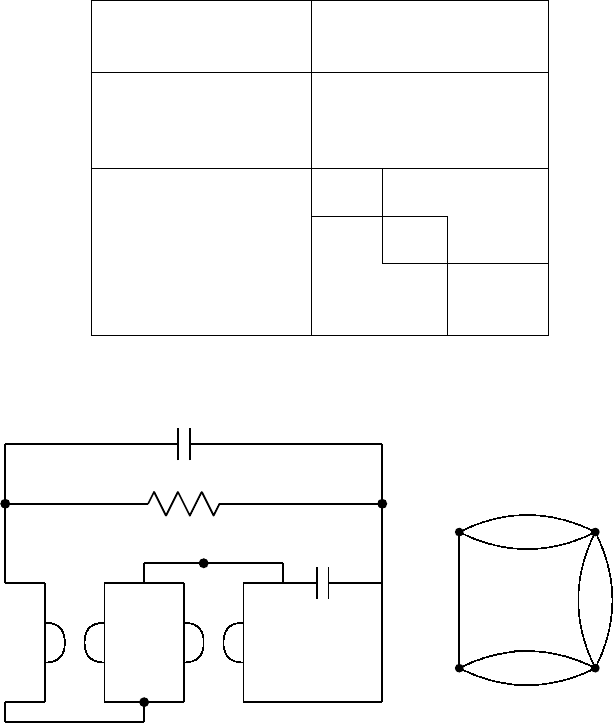Murota K. Matrices and Matroids for Systems Analysis
Подождите немного. Документ загружается.


442 7. Further Topics
M =(V
1
∪ V
2
, F) be the direct sum of M
1
and M
∗
2
, the dual of M
2
,andΠ
be the partition of the ground set V
1
∪V
2
into the pairs of the corresponding
copies. For a pair of feasible sets F
1
∈F
1
and F
2
∈F
2
, it is easy to see that
δ
Π
(F )=|V |−|F
1
/F
2
| holds for F = F
1
∪ (V
2
\ F
2
) ∈F, where F
1
and F
2
are the copies of F
1
and F
2
. Therefore the delta-covering problem on (V,F
1
)
and (V, F
2
) is reduced to the delta-parity problem for M with the partition
Π. 2
An augmenting path algorithm is given by Geelen–Iwata–Murota [93]
for solving the delta-parity problem on linearly represented delta-matroids.
The algorithm consists of O(n) augmentations, each augmentation involv-
ing O(n
3
) elementary pivoting operations. Hence the time complexity of the
algorithm is O(n
4
) in total, where the bound can be reduced slightly with
the use of the so-called fast matrix multiplications. This algorithm can be
adapted to solve the delta-covering problem. Note in this connection that
the delta-parity problem, as well as the delta-covering problem, for a pair
of general delta-matroids is polynomially unsolvable, since it contains the
matroid-parity problem as a special case (see Remark 7.3.2 and Remark
7.3.19).
Remark 7.3.19. The delta-parity problem is a natural generalization of the
matroid parity problem, which has been explained in Remark 7.3.2. For a
matroid M =(V,ρ) with rank function ρ and a partition Π of V into lines,
let ν(M,Π) denote the optimal value of the matroid parity problem, and
δ(M,Π) be the optimal value of the delta-parity problem when M is regarded
as a delta-matroid. Then it is obvious that 2ν(M,Π)=rankM − δ(M,Π).
This shows that the matroid parity problem is a special case of the delta-
matroid parity problem. Moreover, the representation indicated in (7.51)
shows that the linear matroid parity problem is a linear delta-matroid parity
problem.
The augmenting path algorithm of Geelen–Iwata–Murota [93] for the lin-
ear delta-parity problem is based on the idea in the algorithm of Gabow–
Stallmann [83] for the linear matroid parity problem.
Also the min-max theorem (Theorem 7.3.17) for the linear delta-matroid
parity problem is closely related to the Lov´asz min-max theorem (7.44) for
the linear matroid parity problem. To see this, first rewrite (7.44) to
δ(M,Π)=rankM − 2ν(M,Π)
= max
M→M
◦
,{V
i
}
'
ρ
◦
(V ) − 2
i
9
ρ
◦
(V
i
)
2
:
− (ρ(V ) − ρ
◦
(V ))
(
, (7.55)
where the maximum is taken over all matroids M
◦
=(V,ρ
◦
) that are strong
quotients of M and all partitions {V
i
} of V that are compatible with the
partition Π. For the second term in the maximization (7.55) we can show
ρ(V ) − ρ
◦
(V ) = dist(M, M
◦
),

7.3 Mixed Skew-symmetric Matrix 443
where the proof for “≥” relies on the factorization theorem for strong maps
(cf. Kung [168, §8.2.B], Welsh [333, §17.4]) and that for “≤” is straightfor-
ward using (DM). The first term in the maximization (7.55) corresponds to
odd(M
◦
,Π) in the sense that, if {V
i
} runs over direct sum decompositions
of M
◦
,wehave
max
{V
i
}
ρ
◦
(V ) − 2
i
9
ρ
◦
(V
i
)
2
:
= odd(M
◦
,Π).
This follows easily from ρ
◦
(V )=
i
ρ
◦
(V
i
) and the fact that ρ
◦
(V
i
) −
2
;
ρ
◦
(V
i
)
2
<
is equal to 1 or 0 according to whether V
i
is an odd component or
not.
It should be emphasized, however, that the two min-max formulas, the
expression (7.55) and Theorem 7.3.17 (specialized to the matroid parity prob-
lem), are not identical. To be specific, we cannot assume the partition {V
i
}
in (7.55) to be a direct sum decomposition of M
◦
, nor can we assume the
M
◦
in Theorem 7.3.17 to be a strong quotient of M. This subtle point is
demonstrated by the matroid parity problem defined by a linear matroid M
associated with the matrix
v
1
v
2
v
3
v
4
v
5
v
6
v
7
v
8
11000001
00110001
00001101
00000011
over F = GF(2), and a partition Π = {{v
1
,v
2
}, {v
3
,v
4
}, {v
5
,v
6
}, {v
7
,v
8
}}
of V = {v
1
, ···,v
8
}.WehaverankM =4,ν(M,Π) = 1, and δ(M,Π)=
2. In (7.55) we can take M for M
◦
and Π for {V
i
}; then ρ
◦
({v
1
,v
2
})=
ρ
◦
({v
3
,v
4
})=ρ
◦
({v
5
,v
6
})=1andρ
◦
({v
7
,v
8
}) = 2. Note that Π does not
give a direct sum decomposition of M
◦
= M. For Theorem 7.3.17 let M
+
be
the linear delta-matroid defined by a skew-symmetric matrix
A
+
=
v
1
v
3
v
5
v
7
v
2
v
4
v
6
v
8
z
v
1
10010
v
3
01010
v
5
00110
v
7
00010
v
2
1000 0
v
4
0100 0
v
6
0010 0
v
8
1111 1
z 00000001
over GF(2). Fixing a base B = {v
1
,v
3
,v
5
,v
7
} of the matroid M,wecan
identify the matroid M with the delta-matroid (M
+
\{z})/B.ForM
◦
=

444 7. Further Topics
(M
+
/{z})/B,wehave:odd(M
◦
,Π) −dist(M, M
◦
)=3−1=2=δ(M,Π).
Note that the family of feasible sets of M
◦
is given by {{v
i
,v
j
,v
k
,v
7
,v
8
}|
i ∈{1, 2},j ∈{3, 4},k ∈{5, 6}}, and that Π itself gives the finest direct
sum decomposition of M
◦
compatible with Π, where {v
1
,v
2
}, {v
3
,v
4
},and
{v
5
,v
6
} are the odd components. It should be emphasized that M
◦
can be
identified with a matroid, which, however, is not a strong quotient of M. 2
7.3.4 Rank of Mixed Skew-symmetric Matrices
The rank of a mixed skew-symmetric matrix A = Q + T can be treated
successfully by means of the delta-covering problem for the associated linear
delta-matroids.
The following identity is most fundamental, where it is recalled that
the nonsingularity of a principal submatrix of T is characterized by graph-
theoretic terms (see Proposition 7.3.8).
Lemma 7.3.20. A mixed skew-symmetric matrix A = Q + T is nonsingular
if and only if both Q[I] and T [V \I] are nonsingular for some I ⊆ V .
Proof. By the definition of Pfaffians we see
pf A =
I⊆V
±pf Q[I] · pf T [V \ I]. (7.56)
No cancellation can occur among terms with distinct I by virtue of the alge-
braic independence of the nonzero entries of T in the upper-triangular part.
Hence pf A = 0 if and only if pf Q[I] =0andpfT [V \I] = 0 for some I ⊆ V .
The above statement can be rephrased in terms of the union of delta-
matroids as follows.
Theorem 7.3.21. For a mixed skew-symmetric matrix A = Q+T , the delta-
matroid defined by A is the union of the delta-matroids defined by Q and T ,
that is, M(A)=M(Q) ∨ M(T ).
Proof. This follows from the definition (7.52) of the union and Lemma 7.3.20
applied to principal submatrices of A.
Theorem 7.3.22. For a mixed skew-symmetric matrix A = Q + T ,
rank A = max{rank Q[I]+rankT [V \ I] | I ⊆ V } (7.57)
= max{|F
Q
/F
T
||F
Q
∈F
Q
,F
T
∈F
T
}, (7.58)
where M(Q)=(V, F
Q
) and M(T )=(V,F
T
) are the linear delta-matroids
defined respectively by Q and T .

7.3 Mixed Skew-symmetric Matrix 445
Proof. The first identity follows from Lemma 7.3.20, whereas the second is
obtained from Theorem 7.3.21 with Lemma 7.3.15.
The rank formula (7.58) enables us to compute the rank of A = Q + T
by solving the delta-covering problem for (M(Q), M(T )). This can be done
in polynomial time (O(n
4
) to be specific) using arithmetic operations in K
by adapting the algorithm for delta-covering problem for a pair of linear
delta-matroids.
Remark 7.3.23. The linear matroid parity problem can be reduced to the
problem of computing the rank of a mixed skew-symmetric matrix. Given a
pair of matrices B =(b
i
| i =1, ···,N)andC =(c
i
| i =1, ···,N), the
matroid parity problem (cf. Remark 7.3.2) is to find I ⊆ V = {1, ···,N}
of maximum cardinality such that the column vectors {b
i
, c
i
| i ∈ I} are
linearly independent. We denote by ν the optimal value (= max |I|)ofthe
matroid parity problem.
Defining a mixed skew-symmetric matrix
A =
⎡
⎢
⎢
⎢
⎢
⎢
⎢
⎢
⎣
O
b
1
c
1
··· b
N
c
N
−b
T
1
0 t
1
00
−c
T
1
−t
1
0 00
.
.
.
.
.
.
−b
T
N
00 0 t
N
−c
T
N
00 −t
N
0
⎤
⎥
⎥
⎥
⎥
⎥
⎥
⎥
⎦
(7.59)
using indeterminates t
1
, ···,t
N
,wehave
rank A =2(N + ν). (7.60)
Proof of (7.60): The rank identity (7.57) yields
rank A = 2 max
I
(f(I)+|V \ I|),f(I) = rank (b
i
, c
i
| i ∈ I).
Hence it suffices to show ν coincides with ˆν = max
I
(f(I) −|I|). For an
optimal I of the matroid parity problem we have ν = |I| = f(I) −|I|≤ˆν.
Conversely, let I be a maximizer of f(I) −|I| that is minimal with respect to
set inclusion. Then f(I)=2|I|, since otherwise there exists i ∈ I such that
f(I \{i}) ≥ f(I) − 1, which implies that I \{i} is also a maximizer. Hence
ν ≥|I| = f (I) −|I| =ˆν.
The formula (7.60) is equivalent to a well-known identity due to Lov´asz
[178] (cf. Lov´asz–Plummer [181, Theorem 11.1.2]), which reads
rank
N
i=1
x
i
(b
i
∧ c
i
)=2ν, (7.61)

446 7. Further Topics
where b ∧ c = bc
T
− cb
T
(called wedge product)andx
i
(i =1, ···,N)are
indeterminates. The equivalence between (7.60) and (7.61) can be shown
easily by considering a Schur complement of A and using the identity
bc
0 t
−t 0
−1
b
T
c
T
= −
1
t
(b ∧ c)
(see Proposition 2.1.7 for Schur complement). 2
7.3.5 Electrical Network Containing Gyrators
When the branch characteristics of an electrical network are given in terms
of self- and mutual admittances Y , the network can be described by a matrix
A of the form
A =
DO
OR
−IY
, (7.62)
where D is a fundamental cutset matrix and R is a fundamental circuit
matrix of the underlying graph. Recall from §4.7.3 the convention that the
above system of equations describes the “free” network that is obtained after
the branches of voltage sources are contracted and those of current sources
are deleted. Since ker D =(kerR)
⊥
, the matrix A is nonsingular if and only
if DY D
T
is nonsingular (see Lemma 4.7.11). That is, the unique solvability
of the network is equivalent to the nonsingularity of DY D
T
.
Under the genericity assumption that the set of the nonvanishing entries of
Y is algebraically independent over Q, the matrix A above is a mixed matrix.
This makes it possible to formulate the unique solvability of the network in
terms of an independent matching problem (see also Remark 2.3.37 for a
variant of this formulation for the nonsingularity of DY D
T
). This genericity
assumption, though fairly reasonable in many cases, is not always justified.
An ideal element called a gyrator is commonly employed in electrical net-
work theory. It is a two-port element, the element characteristic of which is
represented as
ξ
¯
ξ
=
0 g
−g 0
η
¯η
(7.63)
for the current-voltage pairs (ξ,η), (
¯
ξ, ¯η) at the ports, where g = 0. Note that
the admittance matrix of a gyrator is a skew-symmetric matrix of order two.
Accordingly, it is not reasonable to impose the above-mentioned genericity
assumption on Y when the electrical network in question contains gyrators.
Gyrators are certainly ideal or artificial elements, but they play a pivotal role
in electrical network theory (cf. Rohrer [283], Saito [287]). For example, any
passive network is known to be “equivalent” to an RCG network, which is,
by definition, a network consisting of resistors, capacitors, and gyrators (and
possibly, sources).

7.3 Mixed Skew-symmetric Matrix 447
Example 7.3.24. Consider the electrical network in Fig. 7.5, taken from
Ueno–Kajitani [323], which consists of five elements: two gyrators (two pairs
of branches {1,
¯
1} and {2,
¯
2}), two capacitors C
3
and C
4
(branches 3 and 4),
and one resistor of conductance g
5
(branch 5). It is understood that voltage
sources and current sources are already contracted and deleted, respectively.
The matrix A describing this network is given by
A =
ξ
1
ξ
¯
1
ξ
2
ξ
¯
2
ξ
3
ξ
4
ξ
5
η
1
η
¯
1
η
2
η
¯
2
η
3
η
4
η
5
10−10010
01110−10
00101−11
1 −110−100
0 −101000
−11 00 1 10
00 00−101
−1 g
1
−1 −g
1
−1 g
2
−1 −g
2
−1 sC
3
−1 sC
4
−1 g
5
(7.64)
and the underlying graph G is depicted in the right of Fig. 7.5. 2
a
b
c
d
- -
-
-
1
¯
1
g
1
¯
22
g
2
3C
3
4
C
4
5g
5
ab
cd
3
-
5
-
1
?
4
?
2
6
¯
1
¯
2
Fig. 7.5. An electrical network with gyrators (Example 7.3.24)
Thus we are motivated to consider matrices of the form (7.62) such that Y
is a direct sum of a generic skew-symmetric matrix Y
s
and a generic diagonal
matrix Y
d
. Namely, we consider a matrix

448 7. Further Topics
A =
D
s
D
d
OO
OOR
s
R
d
−I
s
OY
s
O
O −I
d
OY
d
, (7.65)
in which Y
s
is a generic skew-symmetric matrix, Y
d
is a generic diagonal
matrix, D
s
, D
d
, R
s
and R
d
are matrices over a field such that [D
s
D
d
]and
[R
s
R
d
] are of full-row rank and
ker[D
s
D
d
] = (ker[R
s
R
d
])
⊥
, (7.66)
and I
s
and I
d
are unit matrices of appropriate dimensions. In Example 7.3.24,
for instance, we have
Y
s
=
g
1
−g
1
g
2
−g
2
,Y
d
=
sC
3
sC
4
g
5
under the reasonable assumption that {g
1
,g
2
,C
3
,C
4
,g
5
} is algebraically in-
dependent. It is emphasized, however, that Y
s
and Y
d
are not assumed to be
nonsingular, and that Y
s
is not restricted to a block-diagonal matrix consist-
ing of 2 × 2blocks.
The objective of this subsection is to show the equivalence of the nonsin-
gularity of A to that of a certain mixed skew-symmetric matrix associated
with A. This implies by Theorem 7.3.22 that the nonsingularity of A,and
hence the unique solvability of an electrical network described by A,can
be tested by the efficient algorithm developed for the delta-parity/covering
problem.
Remark 7.3.25. Though any passive network is “equivalent” to an RCG
network, this does not mean that the present framework is general enough to
treat an arbitrary passive network under the reasonable genericity assump-
tion. Recall, for example, that an ideal transformer is described as
η
ξ
=
t 0
0 −1/t
¯η
¯
ξ
.
When a network containing transformers are rewritten as an RCG network,
the genericity of the element t is not translated nicely to fit in our present
formulation. 2
First we observe a linear algebraic fact, independent of the genericity of
Y
s
and Y
d
. Define a skew-symmetric matrix
¯
A by

7.3 Mixed Skew-symmetric Matrix 449
¯
A =
⎡
⎢
⎢
⎢
⎢
⎢
⎢
⎣
OO
R
s
R
d
OO
OO
OO−R
s
−R
d
−R
s
T
O Y
s
OO O
−R
d
T
O OO O−Y
d
OR
s
T
OO−Y
s
O
OR
d
T
OY
d
T
OO
⎤
⎥
⎥
⎥
⎥
⎥
⎥
⎦
. (7.67)
Lemma 7.3.26. Let A and
¯
A be defined by (7.65) and (7.67), respectively,
where [D
s
D
d
] and [R
s
R
d
] are of full-row rank and (7.66) is assumed.
3
Then,
det
¯
A = c
2
· (det A)
2
for some c =0.
Proof. First assume that Y
s
and Y
d
are nonsingular and put Z
s
= Y
s
−1
and
Z
d
= Y
d
−1
. Define
B =
R
s
R
d
Z
s
O
OZ
d
R
s
T
R
d
T
= R
s
Z
s
R
s
T
+ R
d
Z
d
R
d
T
.
Taking the Schur complement (Proposition 2.1.7) we see det
¯
A = (det Y
s
·
det Y
d
)
2
· det S, where
S =
R
s
Z
s
R
s
T
−R
d
Z
d
R
d
T
R
d
Z
d
R
d
T
−R
s
Z
s
R
s
T
.
On the other other hand, det S = (det B)
2
, since
det
M −N
N −M
= det[N + M] · det[N − M]
for two square matrices M and N of the same size. Finally, det B = c ·
(det Y
s
·det Y
d
)
−1
·det A for some c = 0 by Lemma 4.7.11. Therefore, det
¯
A =
c
2
· (det A)
2
with nonzero c independent of Y
s
and Y
d
. This identity makes
sense regardless of the nonsingularity of Y
s
and Y
d
.
With the matrix A of (7.65) we associate a mixed skew-symmetric matrix
ˆ
A defined by
ˆ
A =
⎡
⎢
⎢
⎢
⎢
⎢
⎢
⎣
OO
R
s
R
d
OO
OO
OO−R
s
−R
d
−R
s
T
O
ˆ
Y
s
OO O
−R
d
T
O OO O−Y
d
OR
s
T
OO−Y
s
O
OR
d
T
OY
d
T
OO
⎤
⎥
⎥
⎥
⎥
⎥
⎥
⎦
, (7.68)
where
ˆ
Y
s
is a copy of Y
s
but with a new indeterminate for each independent
entry of Y
s
. The matrix
ˆ
A is almost the same as
¯
A, but
ˆ
A is a mixed skew-
symmetric matrix while
¯
A is not because of the repeated occurrence of Y
s
.
3
In this lemma Y
d
can be any symmetric matrix and no genericity assumption on
Y
s
and Y
d
is needed.

450 7. Further Topics
Lemma 7.3.27.
¯
A is nonsingular if and only if
ˆ
A is nonsingular.
Proof. Obviously, the nonsingularity of
¯
A implies that of
ˆ
A.Toshowthe
converse, we use Lemma 7.3.20. Denote by W
1
∪W
2
∪E
s1
∪E
d1
∪E
s2
∪E
d2
the column set of
ˆ
A in the natural order with reference to (7.68). This serves
also as the index set for
¯
A. We have a natural correspondences ϕ
s
: E
s1
→ E
s2
and ϕ
d
: E
d1
→ E
d2
. By the special structure of
ˆ
A we can take I in Lemma
7.3.20 so that I ⊇ W
1
∪ W
2
, ϕ
s
(I ∩ E
s1
)=I ∩ E
s2
and ϕ
d
(I ∩ E
d1
)=
I ∩ E
d2
. Consider now the expansion of the Pfaffian of
¯
A in the form of
(7.56). The term corresponding to the I above has no similar terms, and
cannot be cancelled out. Hence pf
¯
A = 0, i.e.,
¯
A is nonsingular.
The following theorem due to Iwata [142] gives a combinatorial char-
acterization of the nonsingularity of A in (7.65). Put E
s
= Col(R
s
)and
E
d
= Col(R
d
).
Theorem 7.3.28. The following three conditions, (i) to (iii),areequivalent
for the matrix A in (7.65),whereY
s
is a generic skew-symmetric matrix, Y
d
is a generic diagonal matrix, and the orthogonality (7.66) is assumed.
(i) A is nonsingular.
(ii) There exists J ⊆ E
s
∪E
d
such that Y
s
[J ∩E
s
] is nonsingular, Y
d
[J ∩E
d
]
is nonsingular, and the submatrix of [R
s
R
d
] with columns in (E
s
∪ E
d
) \ J
and all rows is nonsingular.
(iii) The associated mixed skew-symmetric matrix
ˆ
A defined by (7.68) is
nonsingular.
Proof. The equivalence of (i) and (iii) is due to Lemma 7.3.26 and Lemma
7.3.27. The equivalence of (ii) and (iii) is implicit in the proof of Lemma
7.3.27.
The above theorem has a number of implications. First, the equivalence
of (i) and (iii) enables us to test for the nonsingularity of A by using the
algorithm for the delta-parity/covering problem. Second, the equivalence of
(i) and (ii) implies as an immediate corollary the unique solvability criterion
for electrical networks, which is explained below.
Let us consider an RCG network, though the following argument is valid
for an electrical network consisting of gyrators and other elements free from
mutual couplings. After the branches of voltage sources are contracted and
those of current sources are deleted, the network is described by a matrix A
of the form (7.65) under the genericity assumption that the element charac-
teristics are independent of one another. In this case, Y
s
is a direct sum of
generic skew-symmetric matrices of order two and Y
d
is a generic diagonal
matrix; both Y
s
and Y
d
are nonsingular. Moreover, [D
s
D
d
] is a fundamental
cutset matrix and [R
s
R
d
] is a fundamental circuit matrix of the underly-
ing graph, say G =(V, E). Note that E = E
s
∪ E
d
for E
s
= Col(R
s
)and
E
d
= Col(R
d
), and that E
s
is partitioned into pairs according to the block
structure of Y
s
.

7.3 Mixed Skew-symmetric Matrix 451
In the literature of electrical network theory a tree in G is called a proper
tree if each pair in E
s
is either contained in the tree or disjoint from the
tree.
4
Similarly, a spanning forest in G is said to be proper if each pair in E
s
is either contained in it or disjoint from it.
The following solvability criterion for an RCG network, essentially due to
Mili´c [194] (see also Recski [277], Ueno–Kajitani [323]), can be derived as an
immediate consequence of Theorem 7.3.28.
Theorem 7.3.29. An RCG network is uniquely solvable (under the gener-
icity assumption) if and only if there exists a proper spanning forest.
Proof. This follows from the equivalence of (i) and (ii) in Theorem 7.3.28. Note
that the submatrix of [R
s
R
d
] with columns in (E
s
∪ E
d
) \ J and all rows is
nonsingular if and only if J is a spanning forest, whereas the nonsingularity
of Y
s
[J ∩E
s
] imposes the properness on the spanning forest.
The connection of the solvability condition above to the matroid parity
problem was pointed out first by Recski [276]. In the special case where
the network consists of gyrators only, the associated mixed skew-symmetric
matrix
ˆ
A takes the form of (7.59), and therefore, testing for the nonsingularity
of
ˆ
A can be reduced to a matroid parity problem, as is shown in (7.60). It
is indicated by Ueno–Kajitani [323] and Recski [277] that the solvability in
the general case can be reduced to solving polynomially many matroid parity
problems; at most (|V | + |E
d
|)|E|
2
problems by Ueno–Kajitani [323] and at
most |E
d
| problems by Recski [277]. Recently, it is observed by Iwata [142]
that a single matroid parity problem suffices, as follows.
Given a graph G =(V,E
s
∪ E
d
) with E
s
partitioned into pairs, we make
acopyofG, denoted G
=(V
,E
s
∪ E
d
), and consider the direct sum of G
and G
, denoted
ˆ
G =(
ˆ
V,
ˆ
E), where
ˆ
V = V ∪ V
,
ˆ
E = E
s
∪ E
d
∪ E
s
∪ E
d
.
The arc set
ˆ
E is partitioned into pairs as follows: {a, b} is a pair in
ˆ
E if (i)
{a, b}⊆E
s
and it is a pair in E
s
, (ii) {a, b}⊆E
s
and it is the copy of a
pair in E
s
, or (iii) a ∈ E
d
, b ∈ E
d
and they are the copies of each other. We
denote this partition of
ˆ
E by
ˆ
Π and call
ˆ
G the duplication of G.
The observation of Iwata [142] reads as follows. Recall the notation ν(·)
for the maximum number of pairs contained in a base.
Theorem 7.3.30. A graph G has a proper spanning forest if and only if
ν(M(
ˆ
G),
ˆ
Π)=r for the duplication
ˆ
G of G,wherer denotes the number
of arcs in a spanning forest of G. Hence, the unique solvability of an RCG
network can be determined by solving a single matroid parity problem for a
graphic matroid.
4
In the literature (e.g., Recski [277]) “normal tree” sometimes used as a synonym
for “proper tree.” A normal tree in an RCG network, however, often means a
proper tree that contains as many capacitors as possible.
